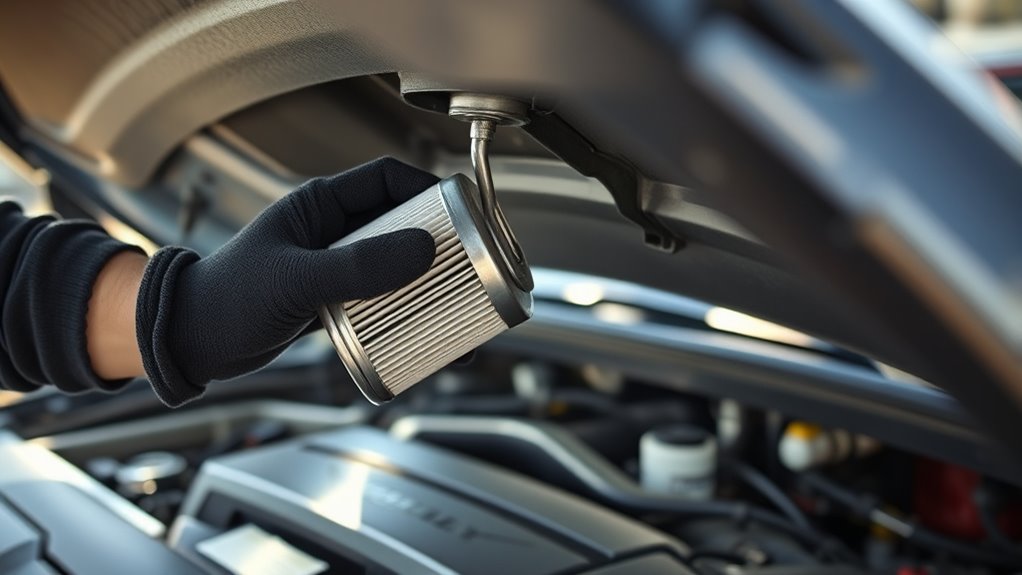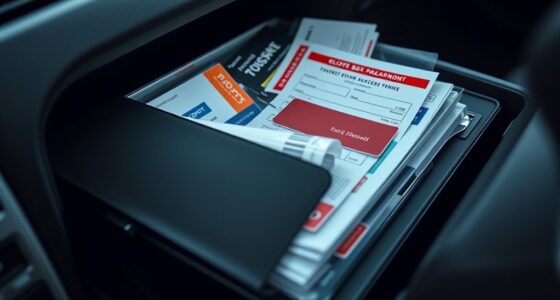To avoid roadside fees, perform regular DIY car maintenance by checking and topping off fluids, inspecting tire pressure, and replacing worn windshield wipers and lights. Keep an eye on belts and hoses for signs of wear and tear, and change your oil and filter routinely. These simple steps catch problems early, preventing breakdowns and costly repairs. Stay proactive, and you’ll be able to maintain your car’s health more efficiently—so keep going to find out exactly how to master each task.
Key Takeaways
- Regularly check and maintain fluid levels to prevent engine damage and costly repairs.
- Inspect and properly inflate tires to improve safety and avoid breakdowns.
- Perform routine oil changes and replace worn belts and hoses to keep the engine running smoothly.
- Monitor brakes and replace pads or rotors promptly to maintain effective stopping power.
- Dispose of used fluids and parts responsibly to prevent environmental fines and ensure safety.
Checking and Replacing Fluids
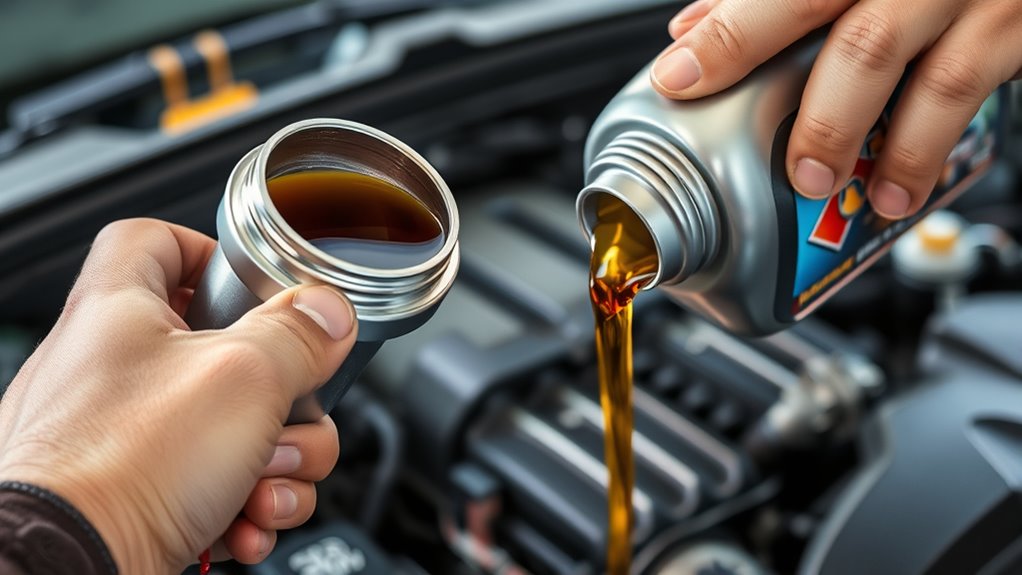
Checking and replacing your car’s fluids is an essential part of DIY maintenance that can save you money and prevent breakdowns. Start by locating the fluid reservoirs—usually under the hood—and check the levels with the dipstick or sight glass. If fluids are low, top them off with the correct type specified in your owner’s manual. Over time, fluids like engine oil, coolant, transmission fluid, and brake fluid degrade, losing effectiveness and potentially causing damage. Regularly substituting these fluids ensures your vehicle runs smoothly and efficiently. Additionally, understanding the importance of color accuracy in vehicle displays can help you monitor dashboard indicators more effectively. Making a habit of routine fluid checks can help you catch leaks early and address issues before they become costly repairs. Routine inspections of coolant and oil levels are especially important for maintaining engine health during different seasons. Being aware of fluid degradation signs can alert you to potential problems before they cause serious damage. Make sure to dispose of used fluids responsibly at a proper recycling center. Routine checks help catch leaks early, saving you from costly repairs and emergency roadside issues.
Inspecting and Topping Up Tire Pressure
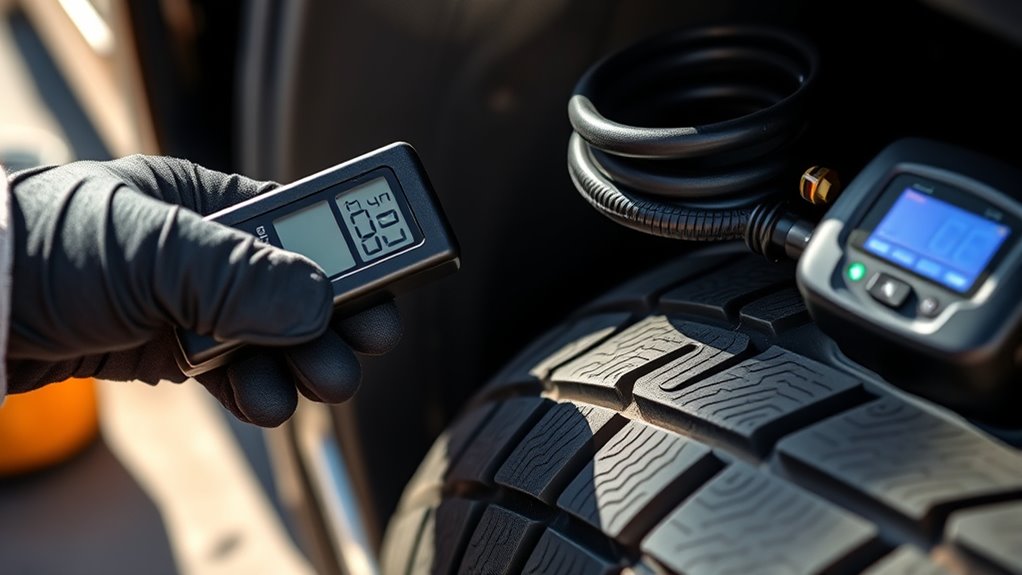
Maintaining proper tire pressure is essential for safe and efficient driving, and it’s easy to do yourself. Start by checking your tire pressure with a reliable gauge. Refer to your vehicle’s manual or the sticker inside the driver’s door for the recommended PSI. If your tires are underinflated, use a compressor or visit a gas station to top them up. Overinflated tires can also cause issues, so adjust to the correct pressure. Regularly inspecting and maintaining tire pressure improves fuel efficiency, extends tire life, and reduces the risk of flats or blowouts. To ensure optimal performance, it’s important to understand tire condition and how it relates to proper inflation practices. Being aware of family photoshoot fails can also help you avoid unexpected mishaps during roadside stops. Additionally, choosing high-quality unique and wicked planters can make your vehicle’s cargo area more organized and visually appealing when transporting plants or gardening supplies. Regularly checking your tire pressure with a reliable gauge is one of the simplest ways to maintain proper tire care and prevent costly roadside fees.
Changing Your Oil and Oil Filter
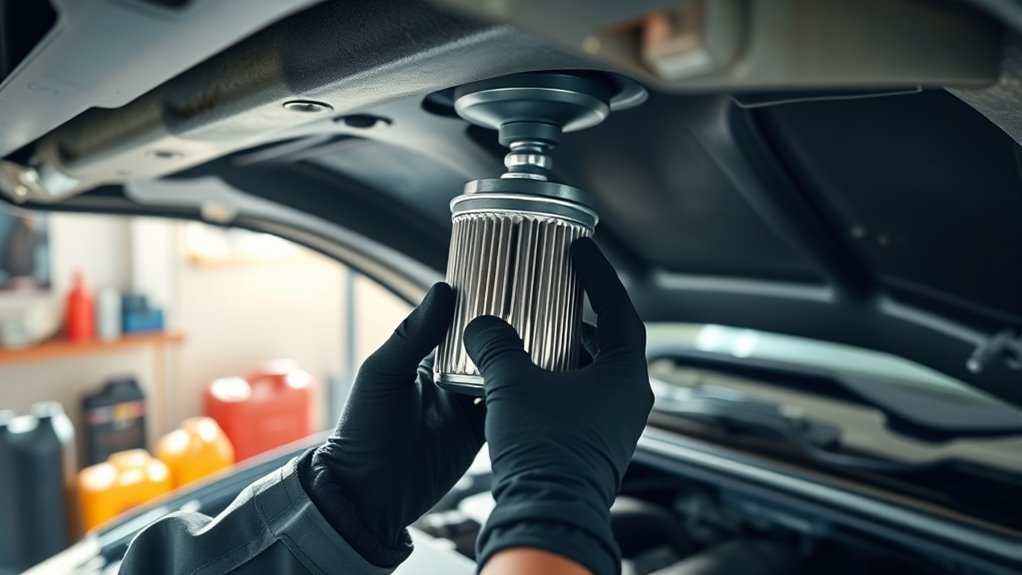
To change your oil and filter, you’ll need some basic tools and supplies like a wrench, oil catch pan, and new filter. Follow a clear, step-by-step process to make sure everything’s done correctly and safely. Don’t forget to dispose of the used oil responsibly to protect the environment. Using proper disposal methods helps prevent environmental contamination and ensures compliance with local regulations. Be sure to double-check the recommended oil type for your vehicle to ensure optimal engine performance. Regular maintenance with the right air filtration systems can also help keep your engine running smoothly and prevent costly repairs. Additionally, maintaining your vehicle’s electric components can improve efficiency and prevent unexpected breakdowns.
Tools and Supplies Needed
Before you start changing your oil and oil filter, gather the essential tools and supplies you’ll need to do the job efficiently. First, get a socket wrench with the correct size socket to remove the drain plug. You’ll also need an oil filter wrench to loosen the filter, along with a drain pan to catch the old oil. Have a funnel ready to pour the new oil without spills, and grab a new oil filter and the appropriate amount of fresh oil specified for your vehicle. Gloves and rags are useful for keeping clean and wiping up spills. It’s also helpful to have a jack and jack stands or ramps to lift the car safely if needed. Being prepared with these tools makes the oil change smoother and mess-free. Additionally, understanding the types of essential oils can help you choose the right products for maintenance tasks beyond just oil changes. Knowing your support hours can also be beneficial if you need assistance with your vehicle or tools during your maintenance routine. Planning ahead by reviewing family background details of your vehicle manufacturer can provide extra insights. Moreover, familiarizing yourself with proper disposal methods for used oil ensures environmental responsibility.
Step-by-Step Replacement Process
Start by warming up your engine for a few minutes to help the oil flow more easily, then turn off the engine and engage the parking brake. Locate your oil drain plug and oil filter. Place a drain pan underneath the drain plug, then loosen and remove the plug to let the oil drain out. Next, unscrew the oil filter using an oil wrench; some oil will spill, so keep the drain pan nearby. Install the new filter by applying a little oil to its gasket and screwing it in by hand, then tighten it snugly. Remember that using self watering plant pots can be a great way to keep houseplants healthy during busy times, as they help maintain consistent moisture levels. Additionally, ensuring your vehicle’s maintenance schedule is up-to-date can help prevent costly repairs later. Maintaining proper vehicle care is crucial for long-term resilience and avoiding roadside fees. Refer to the table below for key steps:
| Step | Tool Needed | Important Tip |
|---|---|---|
| Drain old oil | Drain pan | Keep oil draining completely |
| Remove oil filter | Oil wrench | Use a new filter gasket on install |
| Reinstall drain plug | Wrench | Tighten firmly but avoid over-tightening |
| Install new filter | Hand, oil filter | Oil gasket lubricates for sealing |
| Add fresh oil | Funnel, new oil | Fill to recommended level |
Proper Disposal Techniques
Proper disposal of used motor oil and oil filters is essential to protect the environment and comply with local regulations. You should never pour used oil down the drain, onto the ground, or into storm drains. Instead, follow these tips:
- Collect used oil in a sealed, leak-proof container with a secure lid.
- Take the oil and filters to an authorized recycling center or automotive shop.
- Avoid mixing oil with other fluids, which can complicate recycling efforts.
- Ensure that the disposal process aligns with environmental safety guidelines to prevent contamination and health hazards.
- Staying informed about regulations in your area helps ensure proper disposal and environmental protection.
- Being aware of technological influences on environmental practices can further enhance responsible disposal methods.
- Proper disposal practices also contribute to reducing potential trust issues that might arise from improper handling of hazardous waste.
Replacing Brake Pads and Rotors

Replacing brake pads and rotors is a crucial step in maintaining your vehicle’s stopping power, and doing it yourself can save you money while giving you a better understanding of your car. Start by safely lifting your vehicle and removing the wheels. Next, take off the caliper bolts and carefully slide the caliper away from the rotor. Remove the old brake pads and inspect the rotor for damage or excessive wear. If needed, replace or resurface the rotor. Install new brake pads, ensuring they fit snugly. Reassemble the caliper, tighten bolts securely, and put the wheel back on. Lower your car and pump the brake pedal a few times to seat the new pads properly. This simple process keeps your brakes in top condition and helps avoid costly roadside repairs. Additionally, using quality professional-grade brake components can ensure optimal performance and longevity of your brake system. Regular brake system inspections and maintenance are essential for safety and can help you identify early signs of wear. Understanding proper brake maintenance also helps you identify early signs of wear and prevents unexpected failures, especially since research supports regular inspection as a key factor in preventive vehicle care.
Replacing Windshield Wipers and Lights
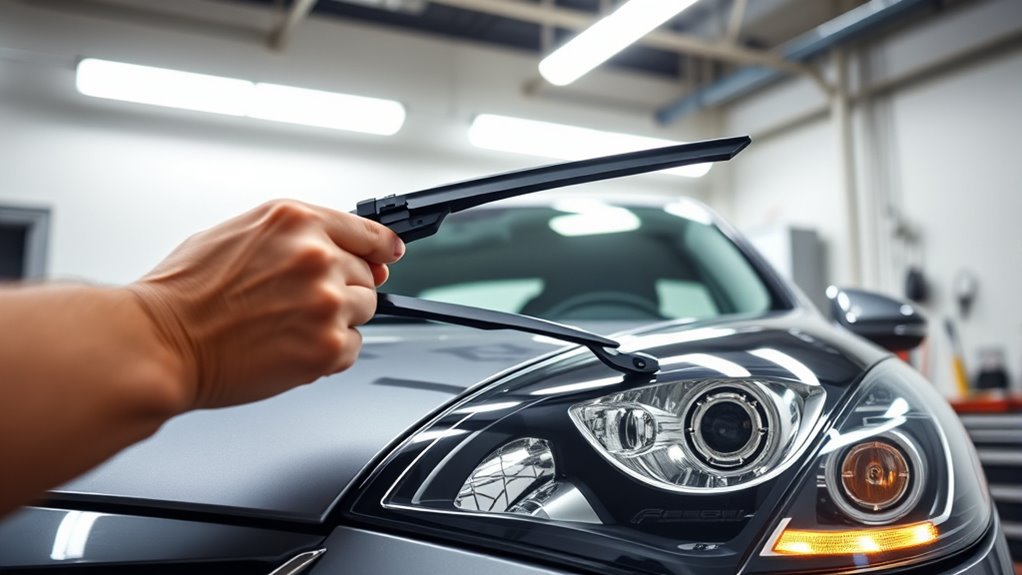
Have you ever struggled to see clearly while driving at night or in bad weather? Replacing windshield wipers and lights is a simple way to improve safety and avoid roadside fees. Start by checking your wipers; if they leave streaks or chatter, it’s time for new ones. To replace them, lift the wiper arm, slide off the old blade, and snap on the new one. For lights, ensure your bulbs are functioning properly—replace any burnt-out bulbs promptly. Regular maintenance also supports vehicle safety and helps prevent lighting system issues, reducing the risk of breakdowns or accidents. Utilizing automated insights can help you identify when components like lights and wipers need attention before problems occur. Here are some tips to make the process easier:
- Choose the right wiper size for your vehicle
- Use gloves to avoid getting oils on bulbs
- Test all lights after replacing to ensure proper function
- Regular maintenance helps prevent lighting system issues and safety hazards in your vehicle’s lighting systems
Keeping these components in top shape ensures clear visibility and safer driving conditions.
Monitoring Belts and Hoses for Wear
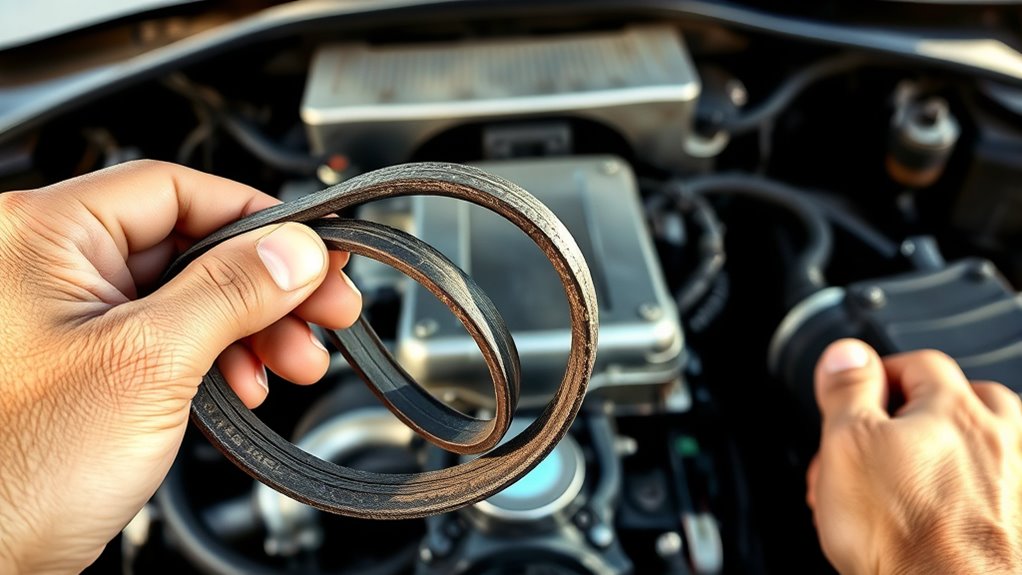
Ever wondered how to catch small problems before they cause major breakdowns? You should regularly inspect your belts and hoses. Look for cracks, fraying, or glazing on the belts—they can weaken over time and snap unexpectedly. Check hoses for bulges, leaks, or soft spots, which indicate deterioration. Feel for stiffness or brittleness, as these signs mean they’re nearing failure. Make sure the belts have proper tension—too loose or tight can cause issues. Also, examine clamps and connections for rust or looseness. Addressing these small problems early saves you from costly repairs and roadside breakdowns. Regular monitoring keeps your engine running smoothly and ensures your car’s reliability, helping you avoid fees and inconvenient delays on the road.
Frequently Asked Questions
How Often Should I Perform DIY Car Maintenance Tasks?
You should perform DIY car maintenance regularly to keep your vehicle in good shape. Check your owner’s manual for specific intervals, but generally, you should inspect your oil monthly and change it every 3,000 to 5,000 miles. Tire pressure and tread should be checked weekly, and filters replaced as needed. Regular maintenance helps prevent breakdowns, saves money, and keeps you safe on the road.
What Safety Precautions Are Essential for DIY Car Repairs?
Just as a sudden rain can catch you off guard, overlooking safety can lead to mishaps. When doing DIY car repairs, always wear gloves and eye protection to prevent injuries. Work in a well-ventilated area, keep a fire extinguisher nearby, and secure your vehicle with jack stands. Being cautious guarantees your safety, so you can focus on fixing your car without unexpected accidents.
Can I Use Generic Parts Instead of OEM for Replacements?
When considering generic parts for replacements, you might wonder if they’re a good alternative to OEM components. You can often use generic parts, but you should verify compatibility and quality first. Some generic parts work just as well and save you money, but others may not last or fit properly. Always research and choose reputable brands to ensure safety and performance, especially if you want your repairs to hold up long-term.
How Do I Identify Signs of Major Mechanical Issues Early?
To spot major mechanical issues early, pay attention to unusual sounds like knocking or grinding. Keep an eye on warning lights on your dashboard, and notice any changes in how your car handles, such as pulling or vibrations. Regularly check fluid levels and tire pressure. If you notice any of these signs, address them promptly to prevent costly repairs and keep your vehicle running smoothly.
Are There Specific Tools Recommended for DIY Car Maintenance?
When you want to do DIY car maintenance, having the right tools makes everything easier. You’ll want a good set of screwdrivers, pliers, and wrenches, plus a jack and jack stands for lifting the car safely. A torque wrench ensures bolts are tight enough, and a multimeter helps with electrical checks. Don’t forget a funnel, gloves, and safety glasses. Investing in quality tools saves you time and helps you avoid costly repairs later.
Conclusion
By mastering these DIY car maintenance skills, you turn yourself from a helpless passenger into the driver of your own safety. Think of your car as a trusted companion—neglect it, and it may leave you stranded. Regular check-ups are your shield against costly roadside fees, ensuring smooth journeys ahead. Take control now; your car’s health is in your hands, and every simple fix is a step toward worry-free driving.
